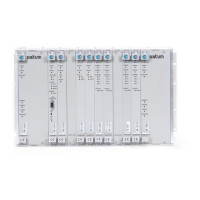SNMP Protocol
386 SSU-2000 User’s Guide 12713020-002-2 Revision D – April 2004
The MIB is controlled by the SSU-2000’s SNMP agent. The SNMP agent is a server
program that sends SSU-2000 status (stored in the MIB database) to the network
manager when the manager transmits
GET or GET NEXT commands. The manager
can also transmit
SET commands that instruct the agent to set MIB variables to new
values. The
TRAP command sets up a communication link that allows the server to
send the manager indications of MIB occurrences, such as a fault condition.
Enabling SNMP
To use the TL1 command to enable SNMP and have the unit transmit all alarms and
events, type:
SET-PRMTR-SNMP-MODE:::::ENA,ALL;
To use the ICS command to enable SNMP and have the unit transmit all alarms and
events, type:
SNMP ENABLE and press ENTER.
Adding a User
TL1 Command
To use the TL1 command to add user XYZ with MD5 authentication using algorithm
HMAC-MD5 with the 16 character authentication key, a 16 character privacy key,
and user level 3, type:
SET-PRMTR-SNMPV3-USER:::::ADD,XYZ,MD5,123456789ABCDEFG,
123456789ABCDEFG,3;
ICS Command
To use the ICS command to add user XYZ with MD5 authentication using algorithm
HMAC-MD5 with the 16 character authentication key, a 16 character privacy key,
and user level 3, type:
SNMP USER ADD XYZ and press ENTER.
At the prompt, type
123456789ABCDEFG (a 16 character authentication key) and
press ENTER.
At the prompt, type
123456789ABCDEFG (a 16 character privacy key) and press
ENTER.
Note: Valid authentication key and privacy key characters include
numbers, upper and lowercase letters, and the character set
":;<=>?@". The semicolon functions properly only in ICS mode, and
the colon must be enclosed in quotes in TL1 mode, as “
USER:NAME”
or
“PASS:WORD”. To enter lowercase letters, enclose the input in
quotes, as “
UserName” or “PassWord”. Do not use spaces in
usernames.

